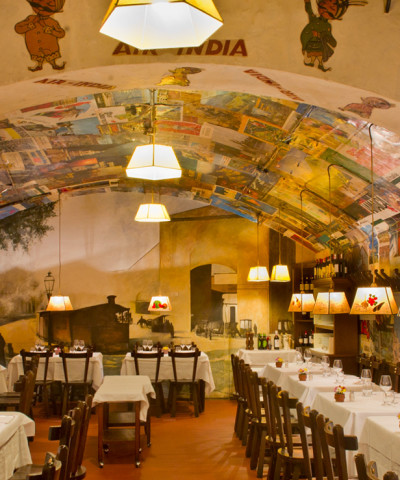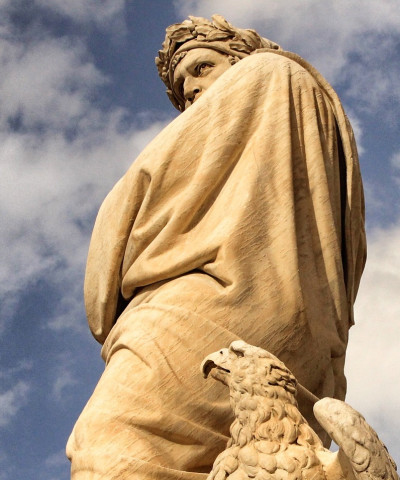San Giovanni. One step away from paradise
Come with us, we take you inside the most sacred Florence
We are ready to take you where the Renaissance shines with a special aura, so palpable that it may seem a dream. Our day in the San Giovanni quarter starts with the aroma of coffee. And what great coffee. There is no Florence more authentic than the one you find in these historic places. Caffè Gilli in Via Roma, an elegant café in the heart of the city with over 250 years of history; Paszkowski Caffè Concerto in Piazza della Repubblica, which from a brewery became a literary café; Caffè Giacosa in Via della Spada: it was here that the famous Negroni cocktail was invented in1920 and then Rivoire, in Piazza della Signoria, created by Enrico Rivoire, chocolatier to the Royal House of Savoy. Breakfast being over, let’s dive into art.
We’re now in front of the Cathedral of Santa Maria del Fiore. The construction of this large building covered with green and white marble began around 1290 under the direction of Arnolfo di Cambio. In 1418 Filippo Brunelleschi added that work of extraordinary genius, the dome, which has become one of the city’s most recognizable icons. Don’t miss the new exhibition of the ancient Church of Santa Reparata, which lies beneath the Cathedral. Let’s proceed on to Giotto’s Bell Tower. The project first entrusted to the famous artist was then continued by Andrea Pisano and Francesco Talenti. Ninety metres in height, with 400 steps leading to the top, it offers a spectacular view of the city. The Piazza’s third wonder is the Baptistery of San Giovanni. Faith, history and art come together in this edifice clad externally in slabs of white marble with green Prato marble inlay. Its three beautiful bronze doors are famous worldwide.
The oldest are the South Doors realized between 1330 and 1336 by Andrea Pisano; then we find the North doors and the East doors, called the “Gates of Paradise”, a masterpiece by Ghiberti and his assistants, including Luca della Robbia. These, as well as many other treasures, will be on display starting from October 29th in the new Museo dell’Opera del Duomo. Walking along the stylish Via Roma - a note for shopping addicts: don’t miss Luisa Via Roma, a multi-brand concept store with the best of international fashion - we come to Piazza della Repubblica. Almost religiously, we’re getting closer to the fateful moment of lunch. Here for you are our favorite addresses.
The gourmet sandwiches at ‘Ino are a real institution. You’ll find them in Via de’ Georgofili. Turning the corner of Via Calzaiuoli don’t forget to stop at I Fratellini. No signs displayed and the taste of authentic Florentine cooking. Now we’re at the Osteria delle Belle Donne, in the street bearing the same name. Checkered tablecloths and walls filled with the portraits of artists and celebrities. Coco Lezzone in Via del Parioncino is a legend. How could it be missing in Florence? Eataly, the mecca of Italian flavours, is in Via de’ Martelli.
Walking toward Piazza Strozzi, here ancient and modern generate a sort of tendency for good taste that is perceived step by step. Perhaps because of the extraordinary exhibitions at Palazzo Strozzi, or the striking presence of the Cinema Odeon, a riot of gold and 1920s glamour. And at night, the same piazza hides the real cult clubs of Florentine nightlife: Colle Bereto (great for aperitifs) and Yab, the iconic disco club.
The centre of political life in Florence since the fourteenth century, our tour moves on to Piazza della Signoria. If it spoke our language, this piazza could tell us about historical events and great triumphs, death and passion, beauty and art. A true open-air museum with the Fountain of Neptune by Baccio Bandinelli, the Equestrian Monument to Cosimo I de’ Medici by Giambologna, the majestic David, the symbol of Florence (the original sculpture by Michelangelo is housed in the Galleria dell’Accademia) and then, like a vision, the beautiful Loggia del Lanzi, sculptural symbol of passion and genius, with the Perseus by Benvenuto Cellini. Surrounded by all this is Palazzo Vecchio, the political symbol of the city. We are now at the Uffizi Gallery.
It would be impossible to enumerate all the masterpieces that can be admired in every single room of the Gallery; we will just name a few of the most marvellous works of art ever created. The Baptism of Christ by Leonardo da Vinci and Andrea del Verrocchio, The Birth of Venus and the Allegory of Spring by Sandro Botticelli, Titian’s Venus, the Madonna and Child with St. John by Raphael, Caravaggio’s Medusa. It begins in the Uffizi Gallery, appears over Via della Ninna, provides a roof over Ponte Vecchio’s shops, skirts the Mannelli Tower, looks onto the Church of Santa Felicita, crosses through the Guicciardini mansions, visits the Boboli Gardens and ends in Palazzo Pitti.
The Vasari Corridor is one of Florence’s most charming places, filled with the history of Florentine culture. This astonishing elevated passageway, one kilometre long, was built in just five months by Giorgio Vasari for the Grand Duke Cosimo I de’ Medici. Shopping time: and where else if not along the elegant Via de’ Tornabuoni? The new pavement, in addition to its recent pedestrianization, makes it a perfect expression of style and taste in the heart of Florence.
The not-to-be-missed boutiques? The temple of Salvatore Ferragamo in Palazzo Spini Ferroni and then Dior, Cèline, Prada, Gucci, Fendi, Bottega Veneta, Emilio Pucci, Stefano Ricci, Balenciaga, Officina de’ Tornabuoni, Bulgari, Pomellato, Barducci, Fani Gioielli, Cassetti Gioielli (on Ponte Vecchio), Omega, Enrico Verità, Richard Ginori, La Perla, Ermenegildo Zegna, and Roberto Cavalli, to name just a few.
Oh, we almost forgot, a little tip on eateries: no novel set in Florence fails to mention its famous truffle sandwiches. We’re talking about Procacci, a delicatessen founded in 1885 in Via de’ Tornabuoni. For an aperitif: the chic minimalism of The Fusion Bar & Restaurant at the Gallery Hotel Art in Vicolo dell’Oro, the glamorous atmosphere of Colle Bereto in Piazza Strozzi, vinyls and craft beer for the new Move On in Piazza San Giovanni. And for dinner? In Florence they’re called ‘buche’ [roughly, holes in the wall], old basement workshops converted into wine cellars, offering Tuscan flavours and cuisine. In this neighborhood you’ll be spoiled for choice: Buca Lapi, Buca Mario, and Buca dell’Orafo. For lovers of haute cuisine, Marco Stabile welcomes us into the starred realm of Ora d’Aria in Via dei Georgofili. A panoramic view of Piazza della Repubblica, a Tuscan bistro with simple, authentic dishes created by Fulvio Pierangelini: all this is Irene, at the Hotel Savoy. And lastly, in Via dei Conti, there’s Konnubio, a place that combines design and nature, cuisine and organic ingredients. Beyond Ponte Vecchio, the wonders of Oltrarno, which we’ll tell you about the next time...











